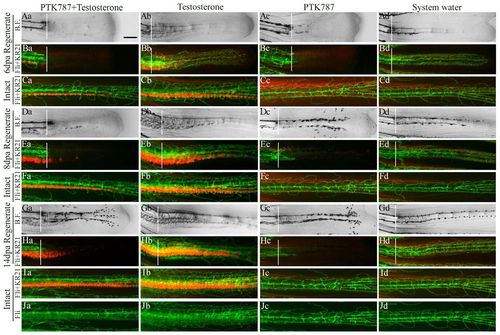Fig. 10
- ID
- ZDB-FIG-140107-22
- Publication
- McMillan et al., 2013 - Regeneration of breeding tubercles on zebrafish pectoral fins requires androgens and two waves of revascularization
- Other Figures
- All Figure Page
- Back to All Figure Page
|
Inhibition of neo-angiogenesis affects T-induced BT growth in the female pectoral fin. (Aa-Ja) A single row of BTs on the intact fin and stump after 6-14 dot with PTK787 and 4-12 dot with T. Small BTs appear in the fin regenerate after 8 dot with PTK787 and 6 dot with T (Da,Ea). A small BT cluster appears on the regenerate after 14 dot with PTK787 and 12 dot with T (Ga,Ha). (Ab-Jb) After 4 dot with T, BTs develop on the regenerate, stump and intact fin and continue to grow from 6-12 dot. (Jb) After 12 dot, the blood vessel network of T-treated females is similar to that of males. (Ac-Jc) PTK787-treated females do not possess BTs. (Aa-Ja,Ac-Jc) Neo-angiogenesis and regenerative outgrowth are inhibited in all PTK787-treated females. (Ad-Jd) System water controls regenerate normally and do not grow BTs. B.F., brightfield. Fli, fli1a:EGFP (green). KR21 (red) outlines the BTs. White vertical lines indicate the amputation plane. Scale bar: 100 μm. |

